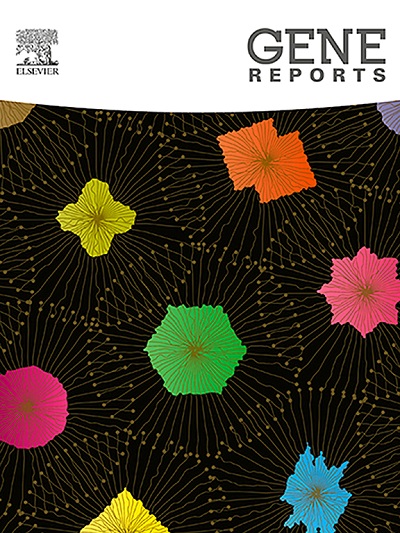Genetic inheritance and resistance patterns of cotton leaf curl disease in upland cotton (Gossypium hirsutum L.)
IF 0.9
Q4 GENETICS & HEREDITY
引用次数: 0
Abstract
Cotton Leaf Curl Disease (CLCuD) has been causing substantial yield losses to the cotton crop in South Asia since its first epidemic in the early 1990s. Researchers face several problems while screening and breeding for CLCuD-resistant varieties due to absence of a reliable screening system, controversial inheritance data, limited genetic information about resistance sources, rapid evolution of viral strains, recombination between two virus groups, narrow plant genetic base, poor management practices, and reliance on small segregating populations. These factors have led to the failure of several cotton varieties that were initially released as resistant to Cotton Leaf Curl Virus (CLCuV). Hence, in the present study, a highly CLCuV-susceptible breeding line, Stoneville-47, tagged with a herbicide resistance marker gene (Round-Up-ready cotton), was crossed with newly discovered resistant accessions, Mac-07 and USG13_1087, to gain insights into the genetic inheritance patterns of resistance against CLCuD. Screening of breeding material against CLCuD resulted in thirty-each resistant (S-0), and susceptible plants (S1-S4) upon grafting with susceptible scions. The qPCR further validated the results, as no viral or betasatellite DNA was detected in resistant plants, unlike the susceptible ones. The Chi-square test of F1 and F2 generations revealed the presence of a single dominant gene or closely linked QTLs with involvement of certain modifying factors or suppressors, controlling CLCuD resistance. These findings suggest that backcross breeding is a suitable method to introduce disease resistance. The circumvention of the suppressors of resistance from the selected progenies can be achieved by raising larger plant populations. However, there is still a need to fine-map the resistance loci, identify key haplotypes, and validate them across diverse genetic backgrounds. Moreover, pyramiding these clusters maybe a straightforward approach to advancing the development of CLCuD-resistant cotton varieties.
陆地棉卷叶病的遗传与抗性模式
棉花卷叶病(CLCuD)自上世纪90年代初首次流行以来,已经对南亚的棉花作物造成了重大的产量损失。由于缺乏可靠的筛选系统、有争议的遗传数据、关于抗性来源的遗传信息有限、病毒毒株的快速进化、两个病毒群之间的重组、狭窄的植物遗传基础、不良的管理实践以及依赖小分离群体,研究人员在筛选和育种clcuda抗性品种时面临着几个问题。这些因素导致了几个最初被释放为抗棉花卷叶病毒(CLCuV)的棉花品种的失败。因此,本研究以高clcuv易感品种stonevil47为材料,标记抗除草剂标记基因(roundup -ready),与新发现的抗CLCuD材料Mac-07和USG13_1087进行杂交,探讨CLCuD抗性的遗传模式。对CLCuD的选育材料进行筛选,得到抗性植株(S-0)各30株,接感接穗后得到感感植株(S1-S4)。qPCR进一步验证了结果,因为与易感植物不同,在抗性植物中没有检测到病毒或betasat卫星DNA。F1代和F2代的卡方检验显示,存在单个显性基因或与某些修饰因子或抑制因子相关的紧密连锁qtl,控制着CLCuD抗性。这些结果表明回交育种是一种引入抗病的合适方法。通过培养更大的植物种群,可以避开所选后代的抗性抑制因子。然而,仍然需要对抗性位点进行精细定位,确定关键的单倍型,并在不同的遗传背景中验证它们。此外,这些集群的金字塔化可能是促进抗clud棉花品种发展的直接途径。
本文章由计算机程序翻译,如有差异,请以英文原文为准。
求助全文
约1分钟内获得全文
求助全文
来源期刊

Gene Reports
Biochemistry, Genetics and Molecular Biology-Genetics
CiteScore
3.30
自引率
7.70%
发文量
246
审稿时长
49 days
期刊介绍:
Gene Reports publishes papers that focus on the regulation, expression, function and evolution of genes in all biological contexts, including all prokaryotic and eukaryotic organisms, as well as viruses. Gene Reports strives to be a very diverse journal and topics in all fields will be considered for publication. Although not limited to the following, some general topics include: DNA Organization, Replication & Evolution -Focus on genomic DNA (chromosomal organization, comparative genomics, DNA replication, DNA repair, mobile DNA, mitochondrial DNA, chloroplast DNA). Expression & Function - Focus on functional RNAs (microRNAs, tRNAs, rRNAs, mRNA splicing, alternative polyadenylation) Regulation - Focus on processes that mediate gene-read out (epigenetics, chromatin, histone code, transcription, translation, protein degradation). Cell Signaling - Focus on mechanisms that control information flow into the nucleus to control gene expression (kinase and phosphatase pathways controlled by extra-cellular ligands, Wnt, Notch, TGFbeta/BMPs, FGFs, IGFs etc.) Profiling of gene expression and genetic variation - Focus on high throughput approaches (e.g., DeepSeq, ChIP-Seq, Affymetrix microarrays, proteomics) that define gene regulatory circuitry, molecular pathways and protein/protein networks. Genetics - Focus on development in model organisms (e.g., mouse, frog, fruit fly, worm), human genetic variation, population genetics, as well as agricultural and veterinary genetics. Molecular Pathology & Regenerative Medicine - Focus on the deregulation of molecular processes in human diseases and mechanisms supporting regeneration of tissues through pluripotent or multipotent stem cells.
 求助内容:
求助内容: 应助结果提醒方式:
应助结果提醒方式:


